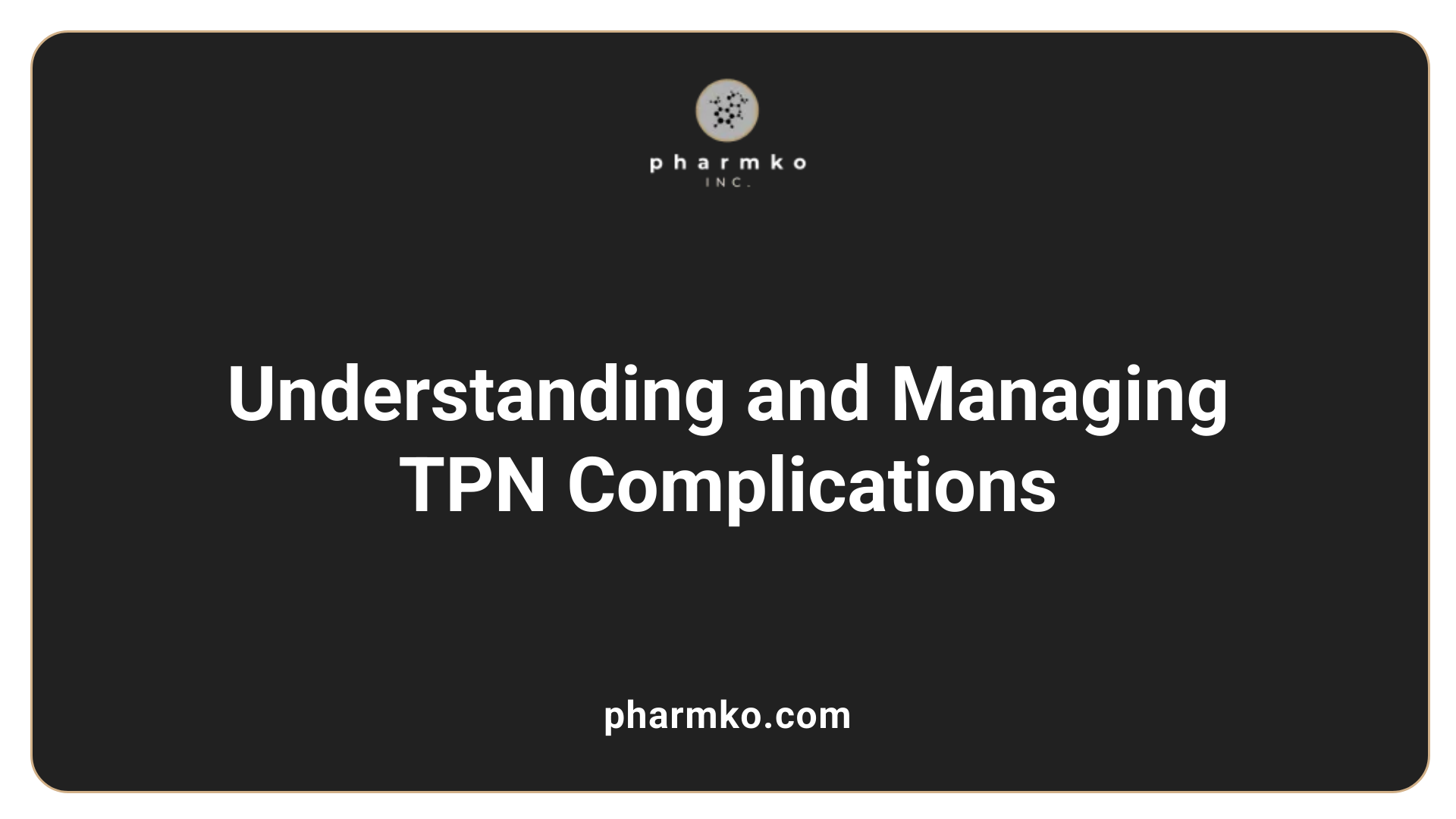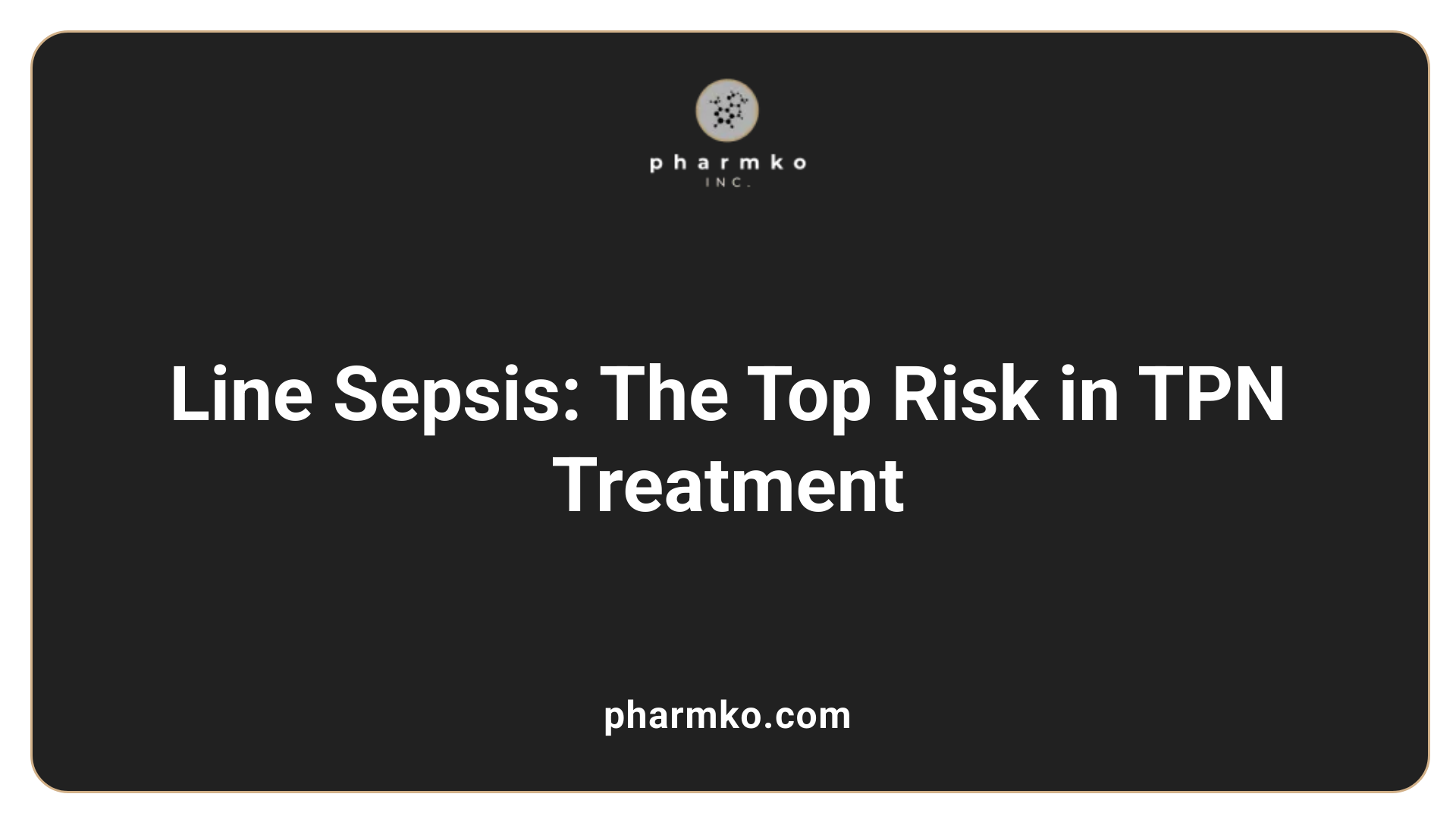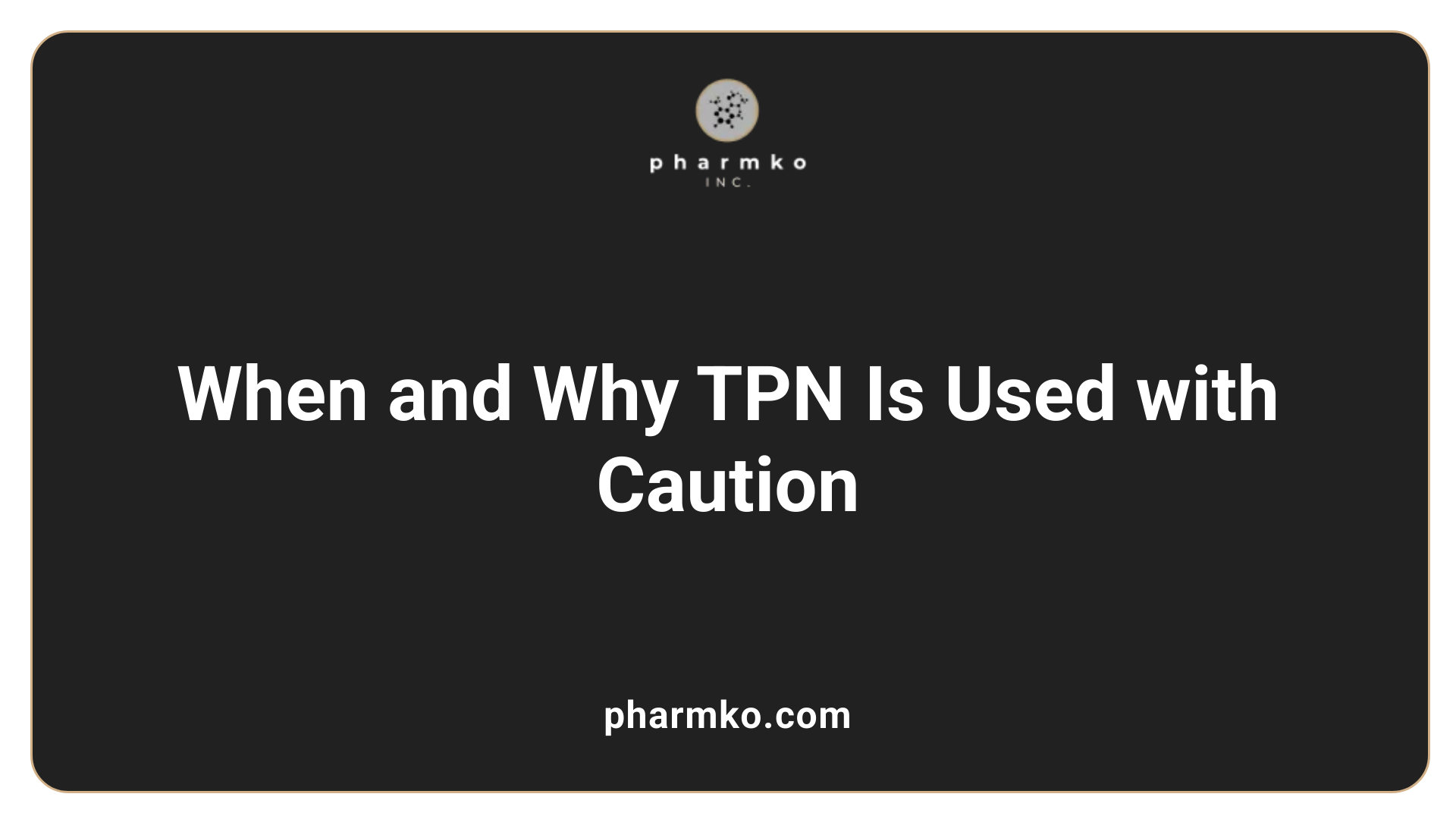Common Myths About Total Parenteral Nutrition Debunked
Understanding Total Parenteral Nutrition (TPN): Myths vs. Facts
Total Parenteral Nutrition (TPN) is a vital medical intervention used to provide nutrition intravenously to patients who cannot meet their dietary needs through oral or enteral methods. Despite its lifesaving potential, there are many misconceptions regarding its safety, complications, and application. This article aims to debunk common myths about TPN by presenting scientific evidence and clarifying what is true versus misconception, ultimately empowering healthcare professionals and patients with accurate knowledge.
Common Complications of Total Parenteral Nutrition

What are the common complications associated with total parenteral nutrition (TPN)?
Total Parenteral Nutrition (TPN) is an essential intervention for patients who cannot meet their nutritional needs through oral or enteral routes. However, its use comes with potential risks and complications that healthcare providers must carefully monitor.
One of the most serious issues is bloodstream infections, particularly central line-associated bloodstream infections (CRBSI). These infections can lead to sepsis, a life-threatening condition requiring prompt treatment. Maintaining strict sterile techniques and proper catheter care are vital measures to reduce this risk.
Metabolic disturbances are also common, including episodes of hyperglycemia, where blood sugar levels are too high, and hypoglycemia, characterized by dangerously low glucose levels. Electrolyte imbalances, such as abnormalities in sodium, potassium, calcium, and magnesium, can occur if the nutrition is not carefully tailored and monitored.
Long-term TPN use may cause liver problems. Fatty liver disease or cholestasis, a condition where bile flow is impaired, can develop over time. Prolonged TPN therapy might also lead to gallstones, due to altered bile composition, and bone issues like osteoporosis resulting from mineral imbalances.
Additionally, the risk of thrombosis at the catheter site is notable. Blood clots can obstruct the catheter or even embolize, posing serious health threats. Micronutrient deficiencies may also arise if the TPN formula is not appropriately balanced, leading to deficiencies in vitamins and trace elements essential for bodily functions.
In summary, while TPN is life-saving, it requires vigilant management to prevent a range of complications, from infections to metabolic and organ-specific issues. Regular monitoring, proper formulation, and adherence to strict infection control protocols are key to minimizing these risks.
The Fear: Line Sepsis as the Most Critical TPN Risk

What is the most feared complication of TPN?
Total Parenteral Nutrition (TPN) is a lifesaving therapy for patients who cannot receive adequate nutrition via the gastrointestinal tract. However, it carries significant risks, with line sepsis being the most alarming complication.
Line sepsis, also called catheter-related bloodstream infection (CRBSI), occurs when microbes colonize the central venous catheter used for TPN administration. This can lead to systemic infection, sepsis, and in severe cases, multi-organ failure.
The danger of line sepsis lies in its potential to cause rapid deterioration in critically ill patients. It is associated with increased morbidity, longer hospital stays, and higher mortality rates if not identified and managed promptly.
Factors influencing the risk include the number of lumens on the catheter, the technique used during insertion and maintenance, and adherence to infection control protocols. Proper aseptic technique and strict catheter care are essential to minimize the risk.
Catheter-related bloodstream infections
CRBSI is the main pathway through which line sepsis develops. Microorganisms such as bacteria and fungi can enter the bloodstream via the catheter tip, especially if proper sterile precautions are not followed. Common causative organisms include staphylococci, including methicillin-resistant strains, and Candida species.
Preventive strategies involve rigorous hand hygiene, use of sterile barriers during insertion, proper skin antisepsis, and meticulous catheter maintenance. Regular assessment for signs of infection, such as fever, chills, or malaise, is essential for early detection.
Impact on patient morbidity and mortality
The consequences of line sepsis extend beyond infection. Patients may experience prolonged hospitalization, increased need for antibiotics, and additional invasive procedures. The systemic inflammatory response can lead to septic shock, multiple organ dysfunction, and death.
Data show that patients with catheter-related infections have a significantly higher risk of adverse outcomes, especially in vulnerable populations like neonates, oncology patients, and those with compromised immune systems.
Importance of infection control protocols
Strict infection control practices are vital for preventing line sepsis. These include standardized insertion procedures, regular site inspection, and prompt removal of unnecessary lines.
Healthcare settings ought to establish comprehensive protocols aligned with guidelines from organizations like CDC and CDC guidelines for central line-associated bloodstream infections. Staff training and compliance monitoring further reduce the risk.
Prevention strategies
Preventive measures are centered around maintaining aseptic technique and appropriate line management:
- Use of chlorhexidine for skin antisepsis during insertion.
- Validation of proper catheter placement and securement.
- Routine dressing changes and disinfection of access ports.
- Limiting the number of catheter lumens and routine assessment for necessity.
- Educating staff and patients on signs of infection.
By implementing these strategies, healthcare providers significantly decrease the incidence of line sepsis, safeguarding patient health during TPN therapy.
Why TPN is Used Cautiously and Sparingly
 Total parenteral nutrition (TPN) is a method of feeding that bypasses the gastrointestinal tract by delivering nutrients directly into the bloodstream. While it can be life-saving in cases where enteral feeding is impossible, it is generally used with caution due to the significant risks and complications associated with this form of nutrition.
Total parenteral nutrition (TPN) is a method of feeding that bypasses the gastrointestinal tract by delivering nutrients directly into the bloodstream. While it can be life-saving in cases where enteral feeding is impossible, it is generally used with caution due to the significant risks and complications associated with this form of nutrition.
One major concern is the risk of bloodstream infections, especially catheter-related bloodstream infections such as catheter sepsis. Since TPN requires a central venous catheter, there is an increased chance of bacteria or fungi entering the bloodstream, which can lead to severe infections.
In addition to infections, catheter placement itself can sometimes cause complications like thrombosis or occlusion. Proper insertion and maintenance protocols are crucial to minimize these risks.
Long-term use of TPN can also lead to liver and metabolic issues. Patients may develop fatty liver, cholestasis, or even cirrhosis due to prolonged TPN therapy. Metabolic complications are common, including blood sugar imbalances like hyperglycemia (high blood sugar) or hypoglycemia (low blood sugar), which require careful management.
Beyond liver and metabolic concerns, extended TPN use can cause metabolic bone disease, electrolyte disturbances, and fatty infiltration of the liver. In malnourished patients, refeeding syndrome—a potentially fatal shift in fluids and electrolytes—is a particular risk during the initiation of TPN.
Because of these potential adverse effects, the use of TPN is typically reserved for patients who cannot meet their nutritional requirements through oral or enteral means. Strict indications, meticulous monitoring, and strict aseptic techniques are essential when administering TPN.
Given these considerations, healthcare providers weigh the benefits against the risks carefully before initiating TPN, making it a therapy that must be managed with specialized oversight in appropriate clinical scenarios.
Debunking Myths: Is TPN Always Dangerous?
What are the common myths about TPN and their truths?
Many misconceptions circulate regarding total parenteral nutrition (TPN), often portraying it as an inherently risky or dangerous intervention. A prevalent myth is that TPN universally leads to severe infections, metabolic derangements, or other complications, which can cause hesitation in its use.
In truth, when administered correctly and with proper monitoring, TPN can be a safe, effective, and lifesaving support for patients who are unable to obtain adequate nutrition through normal eating or enteral routes. The risks associated with TPN, such as infections or metabolic issues, are largely preventable with strict protocols, sterile techniques, and careful patient management.
Scientific studies and clinical guidelines highlight that TPN offers significant benefits in specific situations, including cases of gastrointestinal failure, severe malnutrition, or shortly after major surgeries. The key is patient selection, individualized dosing, and ongoing assessment by an interdisciplinary team. Proper protocols to prevent complications—like catheter-related infections and electrolyte imbalances—are integral to safe TPN practice.
Therefore, TPN should not be viewed as universally hazardous but rather as a carefully managed therapeutic option. When used appropriately, its benefits often outweigh potential risks, especially in patients with no alternative nutritional access.
For healthcare providers, understanding the nuances and correct application of TPN is essential for optimizing patient outcomes. This approach ensures that misconceptions do not hinder the provision of vital nutritional support in appropriate cases, ultimately improving recovery, survival, and quality of life.
Scientific evidence on TPN risks and benefits
Studies consistently show that with proper implementation, TPN outcomes are comparable to other nutritional strategies, with manageable complication rates. The importance of individualized care and vigilant monitoring cannot be overstated.
Balancing the Risks and Benefits of TPN

When is TPN used cautiously or with specific indications?
Total parenteral nutrition (TPN) is a method of feeding that bypasses the gastrointestinal tract, delivering nutrients directly into the bloodstream. Its use is carefully considered because of the significant risks associated with the procedure.
TPN is typically reserved for patients who cannot meet their nutritional needs through oral or enteral routes. This includes individuals with severe gastrointestinal conditions such as bowel obstructions, malabsorption syndromes, or after certain surgeries that impair gut function.
The cautious approach stems from the potential for serious complications. These include infections related to central line placement, metabolic disturbances like hyperglycemia or electrolyte imbalances, and liver damage, sometimes called hepatic steatosis or cholestasis.
Given these risks, clinicians evaluate factors like the patient’s overall health, the expected duration of nutrition support, and available alternative feeding strategies. They aim to only use TPN when benefits outweigh the potential harms, emphasizing a tailored, patient-specific approach.
Proper patient selection, strict adherence to aseptic techniques, and continuous monitoring are essential to ensure safety and effectiveness. This cautious practice helps prevent unnecessary complications while providing essential nutrition to those in critical need.
Alternatives to TPN
For many patients, enteral nutrition (tube feeding) is preferable due to its safety profile and support of gut integrity. Once bowel function is preserved, enteral routes such as nasogastric or gastrostomy feeding are considered first-line options.
Nutritional counseling and dietary adjustments can also help optimize oral intake, minimizing the need for invasive interventions. In some cases, specialized oral nutritional supplements or dietary plans tailored by dietitians can make a significant difference.
When enteral feeding is not feasible or insufficient, parenteral nutrition remains an option, but only after thoroughly exploring and exhausting less invasive alternatives.
Monitoring and managing complications
Patients receiving TPN require vigilant monitoring. Blood tests to track electrolytes, liver function, blood glucose, and signs of infection are standard.
Any complications such as catheter infections, metabolic abnormalities, or liver problems need prompt management. Adjustments to the TPN formulation, antibiotic therapy, or discontinuation may be necessary depending on the issue.
Proper staff training and adherence to protocols ensure safety and improve outcomes. Regular assessment also helps determine the ongoing need for TPN and whether the patient can transition to less invasive nutrition methods.
Long-term outcomes
While TPN can be life-saving, it is generally associated with increased risks of infections, liver disease, and metabolic complications if used long term. Patient survival and quality of life vary widely depending on the underlying condition, the duration of TPN, and management of associated risks.
In some cases, especially for patients with irreversible intestinal failure, long-term home TPN can lead to extended survival and improved quality of life. However, continuous care, monitoring, and adjustments are vital.
Guidelines advocate for balancing the nutritional benefits with the intent to reduce complications, emphasizing multidisciplinary care and regular evaluation to support the best possible outcomes.
The Role of Healthcare Teams in TPN Management
Multidisciplinary Approach
Effective management of Total Parenteral Nutrition (TPN) involves a team of healthcare professionals working together. This includes physicians, dietitians, nurses, pharmacists, and sometimes social workers. Each plays a vital role in assessing the patient's needs, creating individualized nutrition plans, and ensuring safe administration.
Monitoring for Complications
Regular monitoring is essential to detect potential complications early. This includes checking blood glucose levels, liver function tests, electrolyte balance, and signs of infection at catheter sites. Close observation helps prevent issues like infections, metabolic disturbances, or liver problems.
Patient and Family Education
Educating patients and their families about TPN is crucial. They should understand the purpose of TPN, the importance of maintaining sterile technique for catheter care, and recognizing signs of complications. Proper education fosters safety and promotes adherence to treatment.
Ensuring Optimal Nutrition
The healthcare team continuously evaluates and adjusts nutritional formulas to meet the evolving needs of the patient. The goal is to provide adequate macro and micronutrients, support wound healing, and maintain nutritional balance, thereby improving outcomes and quality of life.
| Aspect | Role | Details |
|---|---|---|
| Multidisciplinary Approach | Team Coordination | Physicians, dietitians, nurses, pharmacists |
| Monitoring for Complications | Regular Assessments | Blood tests, infection signs, catheter site checks |
| Patient and Family Education | Skill Building | Sterile techniques, symptom awareness |
| Ensuring Nutrition | Dynamic Adjustments | Tailoring formulas, regular evaluations |
This collaborative effort ensures that TPN is administered safely, effectively, and tailored to each patient's unique needs, optimizing health outcomes.
Ensuring Safe and Effective TPN Practices
While TPN remains a critical component of supportive care for patients unable to meet their nutritional needs through oral or enteral routes, understanding its risks, benefits, and proper management is essential. Emphasizing strict protocols, vigilant monitoring, and individualized treatment plans helps mitigate complications like infections, metabolic disturbances, and liver issues. Dispelling myths and promoting education among healthcare providers and patients will foster safer application of TPN, ultimately improving patient outcomes and quality of life.
References
- 'Debunking 10 nutrition myths: current evidence and understanding ...
- Enteral nutrition in the critically ill: myths and misconceptions
- Debunking Cancer Diet Myths: Dawn Wilson - Cromwell Hospital
- Myths and Facts - B. Braun
- Debunking Common Nutrition Myths - Ivira Health
- 10 common nutrition myths debunked - Mayo Clinic Health System
- Debunking Myths About Nutrition | Adtalem Global Education
- [PDF] Debunking-six-myths-about-enteral-feeding.pdf - ResearchGate













